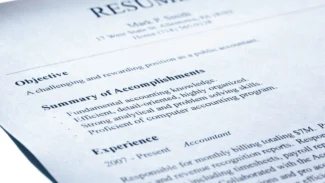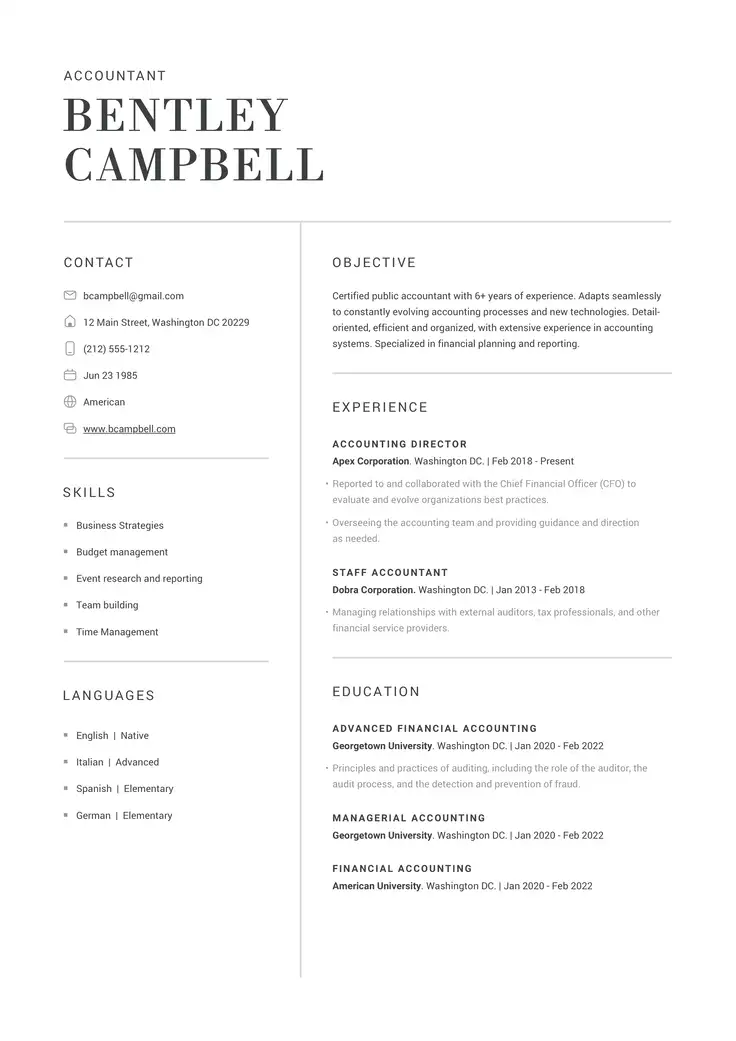You’ve got a resume? Great! You’ll need it if you want to land a job. But what if you don’t have one yet? Or maybe your current resume needs a little work, or it’s time for an update. Whatever the case may be, this post will help you figure out how to make your resume stand out from the crowd.
Think of your resume as a work of art: it should be unique, beautiful, and eye-catching. Many people treat their resumes like they’re looking for a job at McDonald’s—just some boring text with no personality.
But when you think about it, that’s exactly what your resume needs to be: interesting enough to get someone’s attention but not so interesting that they don’t know where to start reading it.
From making sure your accomplishments are front and center to crafting a compelling narrative that highlights why an employer should hire you in particular, there are lots of ways to improve your chances of landing an interview and ultimately getting hired.
So, how do you make sure your resume is both engaging and accessible? Here at ResumeCoach we’ve compiled a complete guide to ideas to make a difference with your resume and have it stand out head and shoulders above the crowd.
Ways to Make Your Resume Stand Out
You’ve spit-and-polished your resume to a tee, but are you really sure it will stand out above the rest? The first, most important step to guarantee your resume is on the right track is to use a resume template to make sure your document complies with accepted formats.
Why settle for a boring MS Word resume that is going to turn off hiring managers? Use a professional, expertly formatted resume template with an appealing and eye-catching design!
By using ReumeCoach’s expert resume builder, you can create a professional document tailored to your industry as a base. Then fill in all of the personal touches that make you a stand-out candidate for your dream job.
However, although it’s an essential first step, using a resume template alone won’t seal the deal with recruiters and leave a lasting impression. With that in mind, we’ve brought together an extensive list of ways to make your resume stand out. Let’s get started!
1. Stick to a recognized format
To keep a recruiter’s eyes on your document, it’s important to use an accepted resume format such as the chronological, functional, or combined style. This ensures your resume sticks to recognizable standards and the hiring manager won’t need to waste time deciphering your document.
Again, if you really aren’t sure how to properly format your resume, use a template! There’s no need to suffer figuring out which style to use when there are uncountable professional online resume templates available at your fingertips!
2. Choose an appropriate font
The font style and size are also important considerations when crafting a resume. Your goal should be to create a document that’s easy on the eyes without making it look too infantile or unprofessional.
If you’re using a computer program like Word or Pages—which have lots of formatting options—you can experiment with different styles until you find one that works well for your needs.
For the body of the resume, use font sizes 12 to 14 and for the headers, use 16 to 20. Keep in mind that some fonts may be readable on a laptop, but are difficult to read on mobile phones or in print.
If you’re using a resume template, stick to the predetermined settings.
3. Use lots of white space
Use lots of white space to make your resume friendly and easy on the eyes. Use it to break up sections, add visual interest, and make your resume look more professional.
White space is a lot like air in a room—it’s important for breathing purposes! When writing your resume, use the “space bar” liberally; it will make all the difference in making your resume feel comfortable for readers to read.
4. Don’t include certain personal identifiers
You should avoid including personal identifiers like your age, race, or gender. The same goes for any photos you have on the resume unless they are specifically requested. In addition to this, you should also omit marital status and religious affiliation from your resume.
This is because in some countries it’s illegal to discriminate against someone based on their gender, religion, or sexual orientation (which could be revealed by asking if they’re married). If a job posting asks for those details then it can be added in a cover letter but otherwise, keep it out of sight on the actual document itself!
Your birth date is also something that shouldn’t appear anywhere other than a separate page at the end of an application packet — this includes when it comes time for hiring managers to look over resumes themselves!
5. Start your resume with a summary statement
It’s the first thing a hiring manager will see and the best way to quickly showcase your skills. While you want to be concise, don’t leave out anything important—you’ll want to include a list of your most relevant skills in order of importance or relevance.
For example: “A natural leader with years of experience managing teams in fast-paced environments.”
If you’re unsure about what should go at number one, here are some categories that may help:
- Communication (verbal, written)
- Presentation skills (including public speaking)
- Writing skills (reports, memos etc.)
Additionally, don’t waste space on your resume by claiming you’re the best candidate. That’s unnecessary since only the recruiter can decide that.
6. Add a career objective statement to your resume if you don’t have much work experience
If you have no work experience or very little of it, a career objective statement can help you get noticed by recruiters. A career objective statement is not just a way to express your career goals; it’s also a tool that helps people focus on their goals.
If you don’t have much work experience but want to still include a resume summary section in your document, then consider adding one as part of the “Experience” section. The two sections are usually combined anyway—and if they’re not combined in most resumes, then they should be!
7. Try not to sound needy if you include an objective
A number of successful job applicants have confessed that they haven’t even bothered to include a job objective on their resume and they landed her dream roles anyway.
This is because some candidates can come across as desperate or too keen to work for the company in objective statements. So if you do include one, be sure to keep it measured. It’s fine to say you’d love to work at the company, but don’t go overboard.
Keep the focus on your worth and why you make for a good candidate!
8. Include only jobs from the past 10-15 years
It’s important to include only jobs from the past 10-15 years. For example, if you were born in 1979 and are 35 right now, then all of your work experience should be no longer than 1994 (25 years ago).
If you are younger than 35 but older than 20 (21 year olds), then all of your work experience should be no longer than 2001 (10 years ago). If you are younger than 20 (19 year olds), then all of your work experience should be no longer than 2008 (5 years ago).
It’s also important to note that if an employer goes through great lengths with a hiring process before deciding on one applicant over another—for example, there were many applicants for a very desirable position—then this can indicate that there aren’t any outstanding reasons why they passed over other candidates.
Therefore at least some degree of job hopping may not stand out as much as it would otherwise on someone else’s resume.
9. However….include notable internships
While including internships is essential on an entry-level resume, they can also prove to be powerful aids even if you are decades into your career.
This is particularly true if you interned at a well-known or highly respected company within your industry. A notable internship could later prove to be an invaluable talking point at an interview.
Of course, if you have a long work history with positions at many well-respected employers, then a long-forgotten internship may not be worth a mention. But you never know, your recruiter may have a particular fondness for the company that gave you your big break.
10. Tailor your job headings
Using specific job heading instead of generic ones gives a stronger impression of your past experiences and abilities.
However, it’s important to keep your job titles believable. If you’re fresh out of college, crafting a student resume, and include titles like ‘CEO’ or ‘Head of Department’, then a recruiter may have a hard time swallowing your ‘achievements’.
11. Only add accomplishments that are relevant to the job at hand
Keep in mind that each accomplishment should be significant and quantifiable: Don’t just say “I helped my team win,” say “I led my team to victory.”
Make sure the accomplishment is relevant to the job at hand: If someone sees that on your resume and thinks “That skill isn’t needed here,” then it won’t help them see you as an ideal candidate for employment—and it may even hurt your chances!
12. Focus on actions, not job tasks
One of the most important things to remember when writing your resume is that your resume is focused on actions and results, not job tasks. This means you should describe what you did, not just what was expected of you or what someone else did.
For example:
- What do I mean by this?
- Instead of saying “Worked with customers,” say “Increased customer retention rate by 20% within 6 months.”
- Instead of saying “Completed administrative tasks,” say “Created an automated workflow system that saved the company over $1 million in labor costs.”
- Instead of saying “Provided support for customers,” say “Helped clients transition from our old product line to the new one smoothly.”
The second thing to keep in mind is that it’s better to focus on what was difficult than easy because nobody cares about easy stuff! You want them to think about how much work went into whatever it is that made a difference for your employer or client, not whether it wasn’t too challenging.
13. It’s important to organize your skills
Including a skills section on your resume is a must so that recruiters can clearly see your specific qualities and the knowledge you have accumulated in your education and previous employment.
However, you shouldn’t just lump everything into one long bullet point list. Divide your skills section into smaller categories to make them easier to identify, e.g hard skills and soft skills.
14. Don’t be afraid to use a little humor
When you’re crafting your resume summary, or even the job headings and descriptions, one sure way to make yourself stand out is to use a little sly humor.
Keep in mind that many hiring managers will be sifting through endless piles of dry, boring resumes for hours on end. If you manage to make a recruiter smile or even chuckle with some carefully employed witticism, you’re bound to stick in their mind.
15. Consider adding a few words from your peers
It’s becoming an increasingly common practice to include a few keywords of qualities that your peers would use to describe you on your resume.
This is a fantastic idea to show recruiters how others perceive you and how you could fit into the working environment. A ‘peer review’ section of just a few buzzwords can really make your resume stand out.
Additional Tips to Make Your Resume Stand Out
We’ve barely scratched the surface when it comes to tips to make your resume stand out. Some other things that can really make a difference with your resume include:
- Deploy powerful action verbs – Beginning descriptions with powerful verbs that denote action help to catch the recruiter’s eye and urge them to keep reading. Pair them with achievements for maximum impact.
- Don’t use unclear or pretentious terms- Avoid jargon or overly complicated phrases. These can be a major turn-off for hiring managers and may make you seem like you’re trying too hard.
- Use keywords the correct way – Many recruiters employ Applicant Tracking Software (ATS) that favor resumes that employ the same keywords as the job description, so be sure to include some! However, it’s important not to keyword stuff, as this can look lazy or unwieldy to human eyes.
- Add hyperlinks to your online presence – Adding functional, clickable links to sites such as your Linkedin profile or professional website can show off your diligence and give hiring managers a clearer picture of who they’re dealing with.
Finally, show off any unique hobbies you may have. Extracurricular activities can make a big impression even if they have nothing to do with your career.
Be sure you include some of your interests in a hobbies section, especially if they are unique and unusual pursuits (such as falconry, restoring furniture, amateur theater, etc.) that can start a conversation.
Reviewing your Resume to Ensure It Stands Out
If you follow the advice above, it’s likely that you’ve already done a great deal of work to make sure your resume stands out.
However, even if you’re feeling confident, it’s always a good idea to give it an additional once-over and review any elements that could be improved.
Here are some tips to consider when reviewing your document to make your resume stand out:
- Prioritize the top third of your document- Make sure you’re making the strongest impression at the beginning of your resume. Most recruiters quickly skim resumes and may not even get past this section if it doesn’t impress.
- Consider whether you need to include short-term jobs – The appearance of job-hopping can turn off recruiters, as they may get the impression you can’t hold down a long-term job. Only include short-term positions if they demonstrate activities relevant to your next role or show career progression.
- Take out your graduation date – Removing the year you graduated helps protect you from age discrimination. Most professional resume templates include dates. However, they can be easily removed.
Additionally, if you’re including a link to your LinkedIn profile, ensure that your resume reflects the info on that page. It doesn’t need to be identical but should give a similar picture and show the same career progression. Make sure dates, job titles, etc. all match.
Check for typos and other errors
You’ve already done all the hard work: you’ve written your resume, proofread it a few times and ensured that it’s error-free. But before you submit it for review, there are still some mistakes that can slip through the cracks.
Use spell check and grammar check to catch any typos or grammatical errors, but don’t stop there. Look for:
- Inconsistencies between verb tenses (e.g., “I was an engineer” versus “I have been an engineer”)
- Misspellings of names or titles, incorrect numbers (a phone number should be written out as 919-555-1234)
- Incorrect dates (don’t list a date range like 4/15/2015 – 4/30/2016),
- Incorrect job titles
This may sound obvious but even people who work in communications often overlook this step because they’re so focused on getting their content across that they miss small mistakes in spelling and grammar (like confusing “their” with “there”).
When proofreading any document—whether it’s for business communication or personal use—it’s crucial to take into account how people will receive it: whether through email, printed copy or online reading experience.
Double-check the format
Taking another good look at the layout and appearance of your document before submitting it is also essential to ensure you have a stand out resume.
Make sure you’ve used the appropriate line spacing throughout the resume The lines should be spaced at 1.15 to 1.5 so the document is easy to read.
Scrutinize the color palette you’ve used on the resume. Does it work? Is it too much? Always try to use a simple color scheme with a maximum of 3 different shades and avoid super bright colors.
Additionally, make sure you save your resume in PDF format! This will ensure that all your hard work formatting the document will stay intact and readable no matter which program the recruiter uses to open your resume file.
Get another pair of eyes on your resume
Even if you’re satisfied by your resume, there’s always the chance that someone else can pick up on small errors or inconsistencies that you just can’t see anymore because of proximity. Friends and family can also be unreliable because they may simply tell you what you want to hear.
Therefore, you should always have at least one professional acquaintance review your resume before sending it in. If you can get more than one pair of professional eyes to review your document and give feedback, then even better!
Resumes that stand out: Examples
If you’re still unsure how to make your resume stand out and are stuck for ideas, you can get plenty of inspiration by browsing our extensive library of resume examples tailored both to specific industries and to your rung on the career ladder!
By following the tips above, you can create a resume that stands out and helps you get the job. There are so many different ways to do this and the key is to find something unique about yourself that will make recruiters take notice. The key is not to give up!
With a little bit of work, your resume can be one of the best tools in your arsenal for getting hired by employers who value diversity on their teams.
Related Blog




